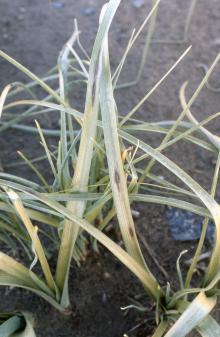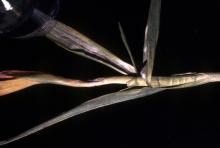See:
Calla Lily (Zantedeschia spp.) - Soft Rot
Cause The bacterium Pectobacterium carotovorum attacks several hosts including calla lily, iris, and dahlia. The organism is in most cultivated soils and regularly overwinters in soil. Bacterial soft rot can attack plants any time of the year but often is noticed in the critical months before bloom. The organism enters through wounds. Seedlings sometimes suffer at the beginning of their second year, and so do established plants that have stayed too long in one place and become congested. The disease has also been associated with contaminated surface waters used for overhead irrigation.
Symptoms Yellowing or browning of leaves, especially the fan's outer leaves, is an early symptom, resulting from a soft decay of the leaf base or of the rhizome itself. Water-soaked streaks on the leaf blades, progressing upward from the base of the leaf fans, are another initial symptom. Rhizomes become rotted and may be foul smelling. Eventually, leaves become dry and brownish-gray and tops die. When infected plants are lifted for dividing, often-empty shells are all that remain of the rhizomes.
Cultural control
- Destroy all infected plants and rhizomes.
- Avoid wounding rhizomes when digging.
- Dry rhizomes in sun and replant in a new well-drained site.
- Plant shallowly to expose part of rhizome to the sun.
- Divide plants frequently enough to avoid serious congestion.
- Use well water or disinfected surface water for irrigation.
Chemical control Combine with cultural control methods because chemical control is difficult and often ineffective.
- Phyton 27 at 1.5 to 2 oz/10 gal water. Group M1 fungicide. 48-hr reentry.
Reference Lacy, G.H., Lambe, R.C., and Berg, C.M. 1982. Iris soft rot caused by Erwinia chrysanthemi, associated with overhead irrigation and its control by chlorination. In Combined Proceedings International Plant Propagators' Society 31:624-634.



